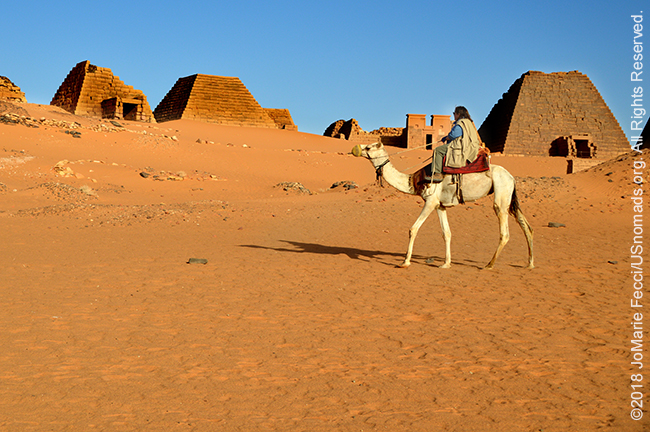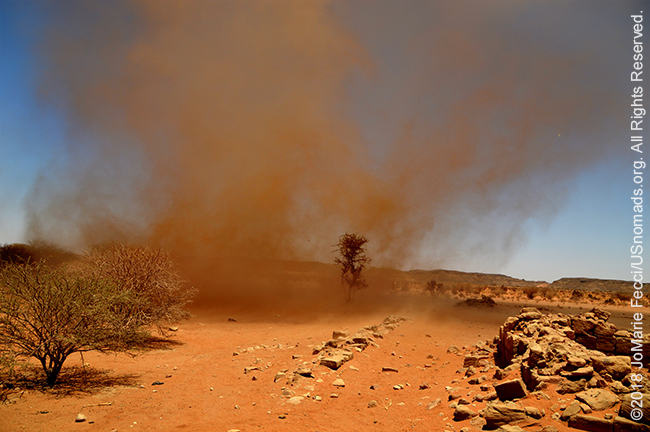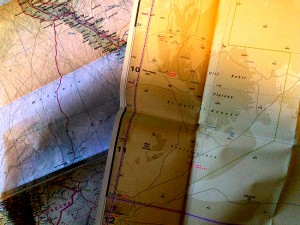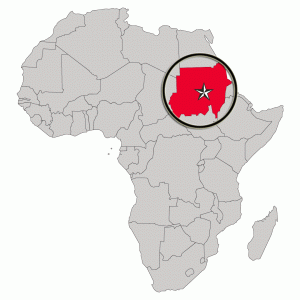
KHARTOUM, SUDAN (12 April 2018) — We slept outside under the stars in the shadow of the Meroe pyramids last night, and I woke up early to catch my last desert sunrise for this trip. It was spectacular as I sat alone on a hilltop overlooking the necropolis as the first rays of light hit the broken pyramids turning them an almost neon orange. The only sign of life was the small figure of a camel rider off in the distance, moving slowly in my direction.
I was in no hurry and just sat watching the rider approach. He was not really in a hurry either and the leisurely gait of the camel reminded me of the rhythm of the music from the Maghreb as it always does when I reflect on it. The rider crossed in front of the pyramids, growing ever larger in the foreground while the sun inched a little higher above the horizon, already feeling warm on my back.
They were coming to meet me, and I signaled to them as I came down from my hilltop perch. I had promised yesterday that I would hire the camel to explore around the necropolis site where we cannot actually drive. Though it is not really that great a distance, and I actually walked a good part of it yesterday evening, I agreed to take the camel partially to support the local tourism economy and partially because I thought this was probably the one time that a camel ride seemed truly appropriate. As we saw while crossing the Bayuda the last few days, the camel is still used here for transportation and really remains integrated in the local culture.
The camel knelt so I could mount up, and soon I was handed the “reins” and left to go on my own towards the pyramids for a bit. Approaching them from high up on the camel at its slow and rhythmic pace was almost hypnotic, putting me into some magical place in my imagination of the past. The camel. The desert. The solitude. And the majestic pyramids.
After a bit of time wandering around the necropolis I returned the camel to his owner who was waiting by the archaeologists’ camp with a few of his friends. The three of them rode off and made a brief “show” of their excellent riding skills for my benefit, galloping their camels in a very regal manner before waving “goodbye” and disappearing around the edge of a dune. It had been an incredible morning, and the day was just beginning.
We left Meroe and the pyramids behind and were soon back on a desert track to visit a few final temple ruins further south. The sites from this ancient kingdom were quite spread out and in between was just open desert with occasional nomadic families passing with their animals en route to a nearby well. And then the desert sand itself rose up in a swirling column of dust almost like a tornado. I had seen these dust columns repeatedly from a distance at various points during our journey, but this time it was closer. I hadn’t been able to really “capture” an image of it before. Now I was photographing it as it swirled about, and then suddenly it started coming closer, as if approaching me. I had to back away, and I thought to myself how easy it would be to believe that this was a manifestation of some desert deity. The very spirit of the Sahara. And just as quickly as it appeared, it was gone, and the desert was silent and calm once more.
This strange “farewell” from the desert on the last leg of the last day out in the sand seemed significant somehow. Maybe it is the influence of steeping myself in the mysteries of the ancient culture but coincidence take son new meanings out here. I continued to think about it as we made our way back to the tar road, heading for hectic chaos of Khartoum…

ABOUT THE EXPEDITION

JoMarie Fecci, of USnomads, sets off on an independent scouting trip across Egypt and Sudan in preparation for an up-coming Sahara expedition. Driving locally-sourced Toyotas and working with small local teams in each region, she will traverse a winding route that jumps off from key points along the Nile as far south as Khartoum, where the Blue and White Niles meet. During the journey she will visit a series of UNESCO world heritage sites focused on the ancient civilizations that occupied the region and meet with local communities. The primary goal of this mission is to assess terrain, security, driving conditions, logistical concerns and approximate timeframes for future travel.
WHERE WE ARE

The Sudan in Northeast Africa is bordered by Egypt to the north, the Red Sea, Eritrea and Ethiopia to the east, South Sudan to the south, the Central African Republic to the southwest, Chad to the west and Libya to the northwest. The country has a total area of 1.861.484 square kilometres (718.722 square miles), making it the third largest in Africa. The terrain is generally flat plains, broken by several mountain ranges. In the west the Deriba Caldera (3,042 m or 9,980 ft), located in the Marrah Mountains, is the highest point in Sudan. In the east are the Red Sea Hills. The name Sudan derives from the Arabic “bilād as-sūdān” or “the lands of the Blacks.” The population of roughly 37 million people is made up of 597 different ethnic or tribal groups speaking over 400 different languages and dialects. Sudanese Arabs are by far the largest ethnic group, estimated to account for 70% of the population. They are almost entirely Muslims. The majority speak Sudanese Arabic, with some different Arabic dialects, while many Arabized and indigenous tribes like the Fur, Zaghawa, Borgo, Masalit and some Baggara ethnic groups, speak Chadian Arabic. The nation’s official languages are Arabic and English. Sudanese history goes back to Antiquity, when the Meroitic-speaking Kingdom of Kush controlled northern and central Sudan and, for nearly a century, Egypt.